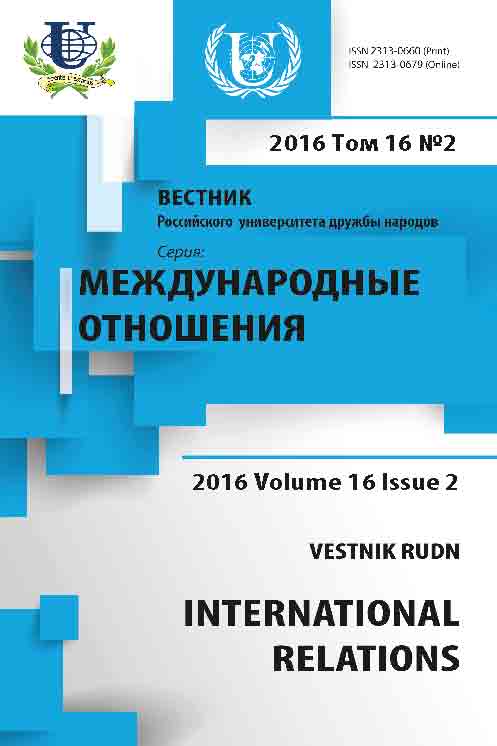Formation of the US global energy strategy in 1991-2015
- Authors: Ponomarev N.V.1
-
Affiliations:
- MGIMO-University, MFA of Russia
- Issue: Vol 16, No 2 (2016): Africa in International Relations
- Pages: 255-264
- Section: Articles
- URL: https://journals.rudn.ru/international-relations/article/view/14274
Cite item
Full Text
Abstract
The article explores the formation of US global energy strategy in the timeframe of 1991-2015 and shifting emphasis in strategic documents indicating new regional priorities. Provisions concerning international energy interests of the United States can be traced back to the very first national security strategy and appear to be inherent core element of the American foreign policy. Due to domestic energy consumption patterns and cold war era strategic perception of fuel reserves US policy has been extensively centered on hydrocarbon resources. It proceeded from initial focus on the Persian Gulf to a global level commitment to ensure all-out output growth and transfer routs diversification for oil and gas exports in a number of key regions including the Caspian, and the Gulf of Guinea. By mid 2000s the US had become increasingly concerned with countering international influence and limiting regional clout of great powers that were pursuing independent policy and relying on state control of national energy companies and foreign energy assets, labeled as «resource nationalism». At the dawn of a new decade climate change in the Arctic and the rise of Indo-Asia-Pacific as a new global foremost transport and economic hub brought these rich in resources and critical in terms of resources shipping maritime domains to the forefront of US policy. Although the US prepares to assume the role of energy exporting country in the wake of shale oil and gas revolution that didn’t cause revision of this strategy but is merely supplementing it with a new international leverage. Revealed continuity rests on interpretation of unconstrained extraction and transit of hydrocarbon supplies to the world market and safety of the transit spaces as essential prerequisites for the stability of the US-centric global economy and entire postbipolar world order. Significant reliance on military instruments to maintain regional security regimes for international energy exports is a principal hallmark of US foreign policy.
About the authors
Nikolay Vladimirovich Ponomarev
MGIMO-University, MFA of Russia
Author for correspondence.
Email: nikolai.ponomarev@gmail.com
Moscow, Russia
References
- Dmitriev S.S., 2014. Energeticheskaya strategiya B. Obamy: opora na innovatsii i tekhnologicheskoe liderstvo [Energy strategy of B. Obama: reliance on innovations and technological leadership]. Moscow, IMEMO, 162 p.
- Chatterjee P., 2009. Halliburton’s Army: How a Well-Connected Oil Company Revolutionized the Way America makes War. NY.: Nation Books, 304 p.
- Geri L.R., McNabb M.C., 2016. Energy Policy in the U.S.: Politics, Challenges, and Prospects for Change. N.Y.: CRC Press, 328 p.
- Kaplan R.D., 2009. Central Stage of the XXI century. Foreign Affairs, Vol. 88-2, pp. 16-29.
- Kaplan R.D., 2010. Monsoon The Indian Ocean and the Future of American Power. N.Y.: Random House, 400 p.
- Klare M.T., 2008. Rising Powers, Shrinking Planet. The New Geopolitics of Energy. London: Metropolitan Books, 352 p.
- Klare M.T., 2012. The Race for What's Left: The Global Scramble for the World's Last Resources. London: Metropolitan Books, 320 p.
- Krane C., 2009. Imported oil and U.S. national security. Santa Monica: RAND Corp. Available at: http://www.rand.org/content/dam/rand/pubs/monographs/2009/RAND_MG838.pdf (date of access: 01.09.2012).
- Lubeck P.M., Watts M.J., Lipschutz R., 2007. Convergent Interests: U.S. Energy Security and the “Securing” of Nigerian Democracy. Center for International Policy. Available at: http//www.ciponline.org/NIGERIA_FINAL.pdf (date of access: 01.09.2012).
- Song Y.-H., 2009. Regional Maritime Security Initiative (RMSI) and Enhancing Security in the Straits of Malacca: Littoral States and Regional Responses. Maritime Security in the South China Sea. Regional Implications and International Cooperation. Wu Sh., Zou K. (eds.). Farbham: Ashgate, pp. 109-135.
- Stokes D., Raphael S., 2010. Global Energy Security and American Hegemony. Baltimore: The John Hopkins University Press, 280 p.











